urham
DURHAM
Durham is a city set on a hill with the river Wear snaking round on three sides. The area within the bend - now virtually all pedestrianised - is mainly taken up with the Cathedral, the Castle and the University. The colleges and narrow cobbled streets give the impression of a steeper version of Oxford or Cambridge. The city grew up around the shrine of St Cuthbert (635-687), whose body arrived here in about 996. It had been removed from the monastery at Lindisfarne in 875 by monks fleeing the Viking invaders and carried around the north of England, spending over a hundred years at Chester-le-Street. Presumably it was felt that the rocky outcrop above the river here offered greater security.
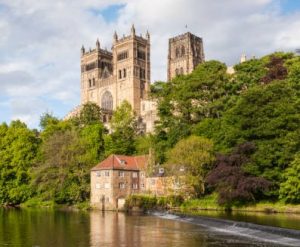
Durham Cathedral
Durham Cathedral (DH1 3EH) has been voted the most beautiful building in Britain and, after visiting, few would choose to argue. It is a triumph of early Norman architecture, completed in the twelfth century, with massive pillars, majestic vaulting and simple arched windows, pre-dating the more elaborate gothic style of other cathedrals. Even later additions, like Prior Castell's fifteenth century clock and the Victorian pulpit, are masterpieces.
At the Reformation, Cuthbert's elaborate shrine at the east end of the cathedral was demolished and his coffin reburied. In the nineteenth century, the remains of the original coffin, together with its contents, were removed and the pieces assembled like a jig-saw on oak boards in their present form. Today Cuthbert's tomb is a plain grey slab in the Chapel of the Nine Altars - the site of the original shrine - with the simple inscription Cuthbertus in gold lettering.
In the cloisters The Treasures of St Cuthbert are displayed in a special exhibition. Here we can see Cuthbert's reconstructed coffin, covered in simple but vigorous carving, the earliest example of Christian carving in England. The style is Mediterranean but the Northumbrian artist produced some entirely new features. The images represent the virgin and child, angels, apostles and the gospel writers with their symbolic beasts. Some of the items recovered from the coffin may have been his personal possessions, including a double-sided ivory comb, a small portable altar and the pectoral cross. This object, exquisitely worked in gold with inlaid garnets, is only about two inches across, but is used as an emblem of the city. Other items, including embroidered vestments, both from the tenth century, and fragments of Byzantine silk from Constantinople, were probably presented by Saxon kings visiting Cuthbert's shrine.
In the Galilee chapel at the west end of the cathedral is the tomb of Bede (672-735), whose History of the English Church and People is one of the very few documents to shed light on the history of the Dark Ages. He lived and died at Jarrow and was buried in the monastery there, but his body was brought to Durham in 1022. In the medieval times, he also had an elaborate shrine, but now lies in a plain black marble tomb, with a candlestick at each corner. On the wall of the chapel is a quotation from one of his works in both Latin and English: Christ is the morning star, who when the night of this world is past, brings to his saints the promise of the light of life and opens everlasting day.
CHESTER-LE-STREET
Like Durham, the fortunes of the town ebbed and flowed with the movements of the mortal remains of the beloved St Cuthbert (635-687). When the monks of Lindisfarne fled from their island in 875 in fear of the Viking invaders, they carried Cuthbert's coffin on their shoulders and were continually on the move for the next seven years. In 882 they came to rest here and built a small wooden church on the site of a former Roman fort, the land apparently granted by Alfred the Great. Along with Cuthbert's remains, the monks also brought with them the Lindisfarne Gospels. According to legend, their boat capsized and their priceless treasure had to be retrieved from the sea, and still bears water stains from the accident. A marginal note in the Gospels identifies the man who wrote the Anglo-Saxon gloss to the Latin text as Aldred of Chester-le-Street.
For the next 113 years, the town became the centre of a vast diocese, but in 995, with Northumbria again under threat of invasion, the monks moved on with their relics and eventually found sanctuary in Durham. Chester-le-Street which had prospered from the visits of kings and nobles coming to worship at Cuthbert's shrine suffered a corresponding decline.
The Church of St Mary and St Cuthbert (DH3 3QB) now stands on the site of the original shrine and volunteers are eager to show visitors around. There is a statue near the altar, illustrating the gruesome legend that Cuthbert was buried holding the head of King Oswald, who had invited Aidan to Lindisfarne after his victory at the Battle of Heavenfield, but was killed seven years later at the Battle of Maserfield in 642. Large panels in the chancel, painted in 1927, and stained glass windows recount the story of Cuthbert's life and his wanderings after death. Other windows celebrate the writing of the Lindisfarne Gospels.
JARROW
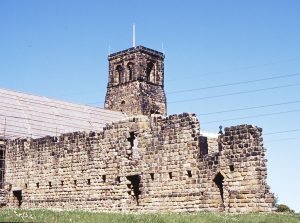
Bede's monastery, Jarrow
The town is remembered for two things - the march of unemployed workers to London in the 1930s and the monastery where the Venerable Bede spent most of his career 1200 years earlier. Founded in 681 by Benedict Biscop (628-690) with Coelfrith as the first abbot, Bede (673-735) entered the monastery as a boy soon after its foundation and, apart from short periods at neighbouring Monkwearmouth, remained here for the rest of his life. He was the greatest scholar in Europe of his day and established Jarrow as a major cultural and educational centre. The books that he wrote or translated represent the finest scholarship of the period. His best known work - The Ecclesiastical History of the English People - is virtually the only original source for much of the Anglo-Saxon period, but he also wrote on philosophy, science, theology, mathematics, medicine and grammar. In the years after Bede's death, the monastery was sacked twice by the Danes and in 1069 the restored parts were razed when William the Conqueror ravaged the north. It was rebuilt five years later but after 1083 gradually fell into disuse.

Stained glass from Bede's monastery
An excellent exhibition called Bede's World, close to the southern entrance of the Tyne Tunnel, closed in 2016 for financial reasons, but has now reopened as Jarrow Hall (Church Lane, Jarrow NE32 3DY). We have not yet been able to visit the new arrangements, so much of the text below relates to the earlier exhibition.
The exhibits celebrate the life and achievements of the great scholar, setting Bede in the context of Roman culture, much of which remained in his day despite the departure of the legions and the arrival of Angles, Saxons and Jutes from northern Europe. As well as the Bede museum, the site also has a reconstructed Anglo-Saxon Village and Living History Farm, with domestic animal breeds selected to resemble those that would have been farmed at the time.
One display describes the career of Benedict Biscop, who in the seventh century made six visits to Rome when even one must have been an adventure. On his return from one trip he accompanied the wise and gifted Theodore of Tarsus as the new Archbishop of Canterbury. On other visits he brought books, vestments and artistic treasures to equip his new foundations at Wearmouth and Jarrow, aiming to establish the Roman pattern of monastic life and discipline. It can reasonably be claimed that Bede could not have achieved what he did without the foundation laid by Benedict.
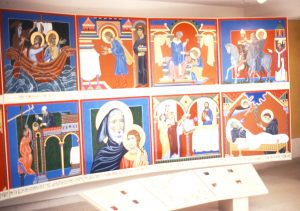
Benedict Biscop tableau
Some exhibits demonstrate the craftsmanship of Bede's time, including the preparation of vellum for books and manuscripts and the use of stained glass. The skill of glassmaking had died out in Britain at this time and Bede records that glass was imported from Gaul, probably through the efforts of Benedict. Fragments of stained glass, among the oldest examples known in Europe, have been found in excavations at the monastic site and fitted into conjectural designs by modern glaziers. Also displayed is a facsimile of the Codex Amiatinus, a copy of the scriptures comparable to the Lindisfarne Gospels, which Coelfrith took as a gift for the Pope. Unfortunately he died on the journey and the original is preserved in Florence.
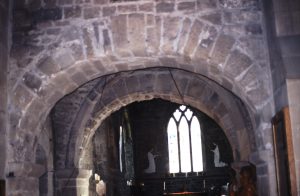
Chancel arch, St Paul's church
A few hundred yards to the south, across Drewett's Park, is St Paul's Church (NE32 3DZ), whose Saxon chancel was part of the original monastery where Bede worshipped. In one of the windows, a beautiful roundel has been created using very early stained glass excavated from the site in 1980. Over the chancel arch is a Latin inscription recording that the monastery was dedicated on 23rd April 685 in the fifteenth year of King Ecgfrith. Also here is a wooden statue of Bede, complete with quill pen, symbolising his importance as a writer.
Bede died in 735, shortly after finishing a translation of John's gospel. He was buried in a special porch on the north side of the church but his body was transferred to Durham cathedral in the eleventh century. The remains of the ruined monastery lie adjacent to the church.
MONKWEARMOUTH
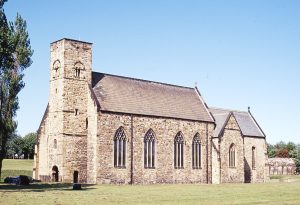
St Peter's, Monkwearmouth
Lying just across the river Wear from Sunderland, the name of the town describes both its location and its role in history. The monastery was founded in 674 on land granted by King Ecgfrith by the much travelled Benedict Biscop, who employed masons and glaziers from Gaul in its construction. Bede started his monastic career here as a young boy before transferring to Jarrow which Benedict founded seven years later.
St Peter's Church (SR6 0DY) stands in a grassy oasis, surrounded by housing estates, not far from the National Glass Centre. A wall and the west tower with its rounded arches are all that remain of the original buildings. A small museum within the church has items excavated from the site. Modern stained glass windows depict scenes from the life of Benedict, Bede and Hild (or Hilda), Abbess of Whitby. In more recent times, John Wesley preached in the church seven times from 1761, being on good terms with the vicar.
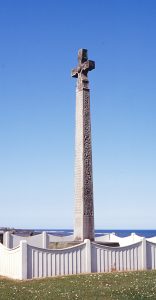
Bede Monument, Roker Cliff
In a little garden enclosure beside the Whitburn Road skirting Roker Cliff Park (SR6 9NS) north of Monkwearmouth is a grey cross 24 feet high, unveiled in 1904 as a national memorial to Bede. Graphic scenes from his life, Saxon-style designs and a quotation from his writings are carved in relief on the column.
In the 20th century, Monkwearmouth was again the scene of spiritual renewal. This time it centred on All Saints Church in Fulwell Road (SR6 0DG). The Rev. Alexander Boddy, vicar from 1866 to 1922, was an evangelical in the Keswick tradition. In 1907 he invited Thomas Barratt, an English Methodist preacher based in Norway, to conduct a series of meetings. This led to a spiritual awakening to which the Pentecostal Church in Britain traces its origins. Among those affected was Smith Wigglesworth (1859-1947), a poorly educated plumber who was already running his own evangelistic mission in Bradford. After receiving prayer from Mrs Boddy, the vicar's wife, he experienced the Baptism of the Holy Spirit and the gift of speaking in tongues.
HOUGHTON-LE-SPRING
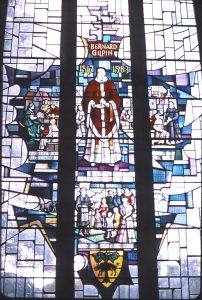
Bernard Gilpin window
The splendid west window of the church of St Michael and All Angels (DH4 4DN) celebrates the life of Bernard Gilpin (1517-1583), known as the Apostle of the North, who was rector here from 1558 until his death. Born at Kentmere, Cumbria, to a distinguished northern family, Gilpin attended Queen's College, Oxford, and was ordained in 1542. At first he had no particular interest in reformed views, but attacked the abuses of the clergy when he preached before Edward VI in 1552. Residing in France from 1553 to 1556, he became a more vigorous exponent of the Reformation and on his return became rector of Easington, and later rector of Houghton, through the influence of his uncle Bishop Tunstall of Durham. Protected for a time by Tunstall, he was eventually arrested by Queen Mary's agents. On the journey south for trial, he providentially broke his leg and by the time he had recovered, Mary was dead.
Gilpin's time at Houghton was marked by his care for the poor, extensive preaching journeys to remote northern communities and promotion of education. He founded an important grammar school, which used to occupy the buildings to the east of the church known as the Kepier Hall. Gilpin's life came to an untimely end when he was trampled by an ox in the market place at Durham. His tomb is in the south transept of the church; nearby is a brass to Margery Bellasis, a wealthy widow with twelve children, who was one of his main supporters.
IRESHOPEBURN
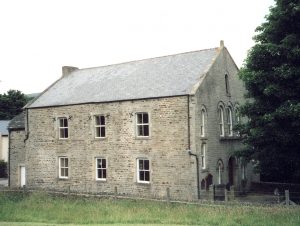
High House Chapel
High up in the Pennines, close to the border with Cumbria, is High House Chapel - the fruit of John Wesley's labours in these parts (DL13 1HD). It stands beside the main road and claims to be the oldest Methodist chapel to have held weekly services since its foundation in 1760. The adjoining house is now the Weardale Museum. Wesley came year first in 1752 and made twelve further visits in subsequent years. His ministry was particularly effective with children and entries in his diary make affectionate reference to their character "..... Phoebe Teatherstone, a child of uncommon understanding; Hannah Watson, ten years old, full of faith and love; Aaron Ridson, not eleven years old but wise and staid as a man; Sarah Smith, eight years and a half old, but serious as a woman of fifty; Sarah Morris, fourteen years of age, is as a mother among them....."
The chapel is beautifully kept, with a gallery, red carpeting and plush red cushions on the pews. In the museum, one room downstairs is devoted to Methodist memorabilia - books, china and prints of scenes from Wesley's life. Upstairs are exhibits devoted to Weardale life - the railway, lead mining and agricultural implements. The incomparable scenery of the Pennines can have changed little since Wesley's time. The Methodist legacy is a string of Wesleyan chapels along the valleys - some still in use but many now adapted to other purposes.


